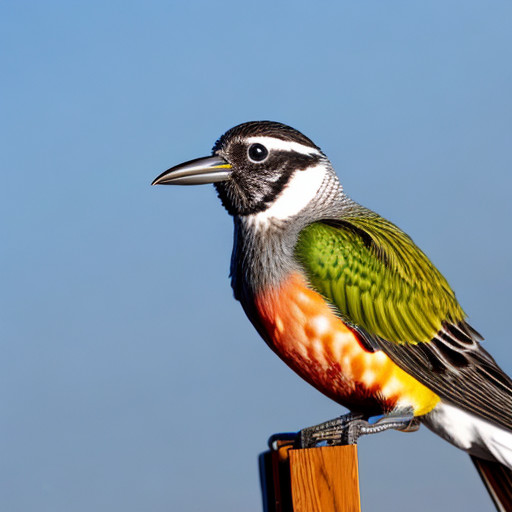Birds, an enchanting and fascinating group of creatures, have long captivated our curiosity. As they soar through the skies with grace and agility, a question arises in our minds: are birds warm-blooded? This query delves into the captivating world of avian biology, exploring the remarkable mechanisms that allow these feathered wonders to regulate their body temperature independent of their environment. In this article, we will unravel the mysteries of bird thermoregulation and shed light on the awe-inspiring adaptations that make them true masters of their own heat.
1. Introduction
When it comes to the animal kingdom, there is a diverse range of creatures with varying characteristics and adaptations. One intriguing aspect is the regulation of body temperature, and birds are particularly fascinating in this regard. Birds are warm-blooded animals, a term often associated with mammals. In this article, we will delve into the definition of warm-blooded, explore the unique characteristics of birds, compare them with cold-blooded animals, examine their adaptations for maintaining a constant body temperature, and highlight specific bird species with distinctive thermoregulation mechanisms.
2. Definition of Warm-blooded
Being warm-blooded refers to an organism’s ability to maintain a stable internal body temperature, regardless of the surrounding environmental conditions. Warm-blooded animals, also known as endotherms, possess the physiological mechanisms necessary to generate and maintain their body heat. This ability allows them to thrive in diverse habitats and withstand extreme temperatures. Birds are considered warm-blooded animals, along with mammals, which sets them apart from their cold-blooded counterparts like reptiles and amphibians.

This image is property of images.unsplash.com.
3. Characteristics of Birds
3.1 Feathers
One of the defining characteristics of birds is their unique adaptation – feathers. Feathers serve multiple functions, including flight, insulation, and display. They help birds maintain their body temperature by trapping air within the plumage, acting as excellent insulators. The arrangement and condition of feathers play a crucial role in regulating heat loss, ensuring birds can remain warm even in cold environments.
3.2 Beak and Claws
Birds’ beaks and claws are also essential for their thermoregulation. The beak serves as a sensory organ, assisting in the detection of prey or food sources. It allows birds to conserve energy by efficiently acquiring and consuming their nourishment. The claws, on the other hand, aid in gripping and perching, enabling birds to roost in elevated locations and avoid colder ground temperatures.
3.3 Lungs
Birds have highly efficient lungs, which contribute to their warm-blooded nature. The structure and functionality of their respiratory system allow for increased oxygen intake, necessary for the high metabolic rates associated with endothermy. The presence of air sacs in addition to lungs allows for a continuous flow of oxygen, ensuring a steady supply of energy to maintain body temperature.
3.4 Skeleton
Birds possess a lightweight and adaptable skeleton, ideal for their aerial lifestyle. This skeletal structure not only supports their body during flight but also assists in thermoregulation. The hollow bones of birds reduce their weight, allowing for more efficient use of energy during flight and minimizing heat loss.
3.5 Reproduction
Birds’ reproductive system also plays a role in their warm-blooded nature. The process of incubation, where the parent bird maintains a constant temperature on the eggs, ensures the unhatched offspring are protected from external temperature fluctuations. This dedication to maintaining a precise temperature showcases the adaptability and commitment of birds to their warm-blooded lifestyle.
4. Regulation of Body Temperature
4.1 Endothermy
Endothermy refers to the ability of warm-blooded animals to generate and maintain their body heat internally. In birds, this is achieved through metabolic processes that produce heat as a byproduct. The high metabolic rate of birds allows them to generate sufficient heat, enabling them to stay warm even in cooler environments.
4.2 Metabolism
Birds possess a rapid metabolic rate, in part due to their high-energy flight requirements. This increased metabolic rate aids in heat production and allows for efficient energy utilization. The continuous breakdown of food and conversion of nutrients into energy sustains the internal body temperature of birds, making them well-equipped for varying climatic conditions.
4.3 Insulation
Insulation is crucial for maintaining body temperature, especially in warm-blooded animals. Feathers serve as an effective insulating layer in birds, trapping air and creating a barrier between the body and the environment. This insulation prevents heat loss, conserving the energy produced by their metabolism and ensuring that birds can remain warm even in colder surroundings.
This image is property of images.unsplash.com.
5. Comparison with Cold-blooded Animals
5.1 Ectothermy
Cold-blooded animals, also known as ectotherms, rely on external factors to regulate their body temperature. Unlike warm-blooded animals, they do not have the physiological mechanisms to generate heat internally. Instead, they depend on environmental conditions, such as sun exposure, to raise or lower their body temperature. Reptiles and amphibians are notable examples of ectothermic animals.
5.2 Environmental Adaptation
Cold-blooded animals adapt their behavior based on environmental temperatures, seeking warmer areas to raise their body temperature or cooler areas for thermoregulation. They experience fluctuating body temperatures, which can impact their overall activity and metabolism. In contrast, warm-blooded birds possess advanced adaptations that allow them to maintain a constant body temperature, regardless of external conditions.
6. Warm-blooded Adaptation in Birds
6.1 Countercurrent Exchange
Countercurrent exchange is a crucial mechanism present in birds that aids in maintaining body heat. It involves the flow of warm arterial blood and cool venous blood in close proximity, allowing for heat transfer between the two. This ensures that as warm blood travels toward the extremities, it warms the cooler blood returning to the body core, minimizing heat loss to the surroundings.
6.2 Shivering Thermogenesis
Shivering thermogenesis is a physiological response exhibited by birds when facing cold temperatures. It involves the rapid contraction and relaxation of muscles, generating heat through metabolic processes. Shivering thermogenesis helps birds increase their body temperature and combat the loss of heat in chilly environments.
6.3 Torpor and Hibernation
Some bird species employ torpor as a method of surviving extreme cold or scarcity of food. Torpor is a state of decreased physiological activity, characterized by lowered body temperature and metabolic rate. Birds enter torpor to conserve energy and maintain their body temperature during periods of unfavorable conditions. Hibernation, a similar process seen in certain bird species, involves an extended period of torpor during the winter months.
This image is property of images.unsplash.com.
7. Evidence of Warm-bloodedness in Birds
7.1 Constant Body Temperature
A defining characteristic of warm-blooded animals is the ability to maintain a constant internal body temperature. Birds exhibit this stability, regardless of external fluctuations. Unlike cold-blooded animals that experience temperature changes with their environment, birds’ body temperature remains relatively constant, reflecting their warm-blooded nature.
7.2 High Metabolic Rate
Warm-blooded animals, including birds, have a higher metabolic rate compared to their cold-blooded counterparts. The elevated metabolism facilitates the efficient production of heat required to maintain the desired body temperature. Birds’ high metabolic rate enables them to sustain their energy-demanding flight patterns and activities while preserving warmth.
7.3 Ability to Fly
The ability of birds to fly further highlights their warm-bloodedness. Flight demands extensive energy expenditure, which necessitates a high metabolic rate and a continuous generation of body heat. The ability to engage in sustained flight distinguishes birds as one of the most energetically demanding warm-blooded organisms.
8. Bird Species with Unique Thermoregulation
8.1 Penguins
Penguins are an intriguing example of bird species with unique thermoregulation adaptations. Despite living in cold and icy habitats, they possess specialized adaptations to withstand low temperatures. Their dense plumage, body fat, and tightly packed feathers provide exceptional insulation, minimizing heat loss. Additionally, penguins employ a fascinating adaptation known as “huddling,” where individuals gather in tight groups to share body heat and maintain warmth collectively.
8.2 Hummingbirds
Hummingbirds exhibit impressive thermoregulation capabilities, considering their small size and energetic lifestyle. To maintain their high metabolic rates, hummingbirds possess a rapid heartbeat and consume large quantities of nectar. This constant energy intake fuels their flight and allows them to sustain their warm-blooded nature, even in cooler environments.
8.3 Ostriches
Ostriches, the largest living birds, have developed distinct thermoregulation strategies suited for hot climates. They possess limited feather density, allowing for better heat dissipation. Their long legs also help keep their bodies elevated from the hot ground, reducing heat absorption. By adapting to their arid habitats, ostriches showcase the versatility of warm-blooded birds in various environmental conditions.

9. Conclusion
Birds exemplify the remarkable adaptations and characteristics associated with warm-blooded animals. Their ability to regulate body temperature internally through endothermy, along with their unique anatomical features and behavioral traits, sets them apart from cold-blooded animals. The presence of feathers, efficient respiratory systems, and high metabolic rates all contribute to birds’ warm-blooded nature. Despite diverse habitats and climates, birds showcase their adaptability and thermal stability through mechanisms such as countercurrent exchange, shivering thermogenesis, and torpor. Whether soaring through the skies, swimming in frigid waters, or navigating arid landscapes, birds continue to captivate our fascination with their warm-blooded adaptations.


